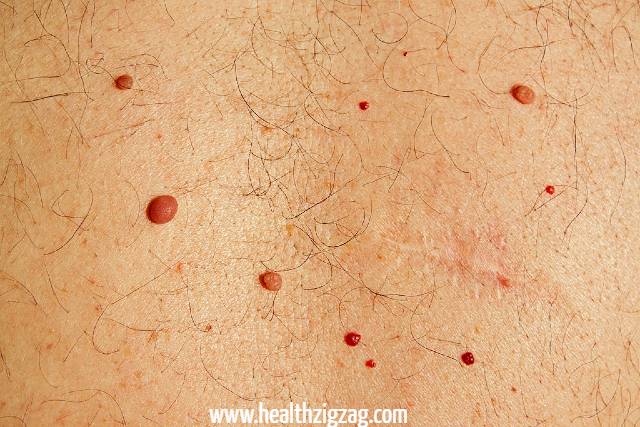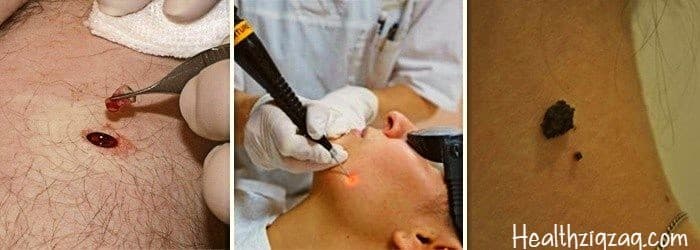
Contents
- 1 Red moles on the body – what is it?
- 2 Types of red dots (angiomas)
- 3 Causes of the appearance of red moles on the skin
- 4 How to remove red dots on a human body
- 5 Home treatment with alternative methods
- 6 Are angiomas dangerous?
- 7 What to do if a red mole itches?
- 8 Can I sunbathe and lead an active lifestyle?
Angiomas, known as red moles. In medical practice, it is customary to refer to formations of a benign nature. Which consists of lymphatic or blood vessels. Their appearance is due to the impaired functioning of either the circulatory or lymphatic systems. They form during the entire period of a person’s life. But only in children under 7 years of age can angiomas disappear on their own.
Red moles on the body – what is it?
What do the red moles present on the body mean?. According to experts, they are an intermediate link between a malformation and a tumor. The medical literature provides a small amount of information about this phenomenon. This is because red moles do not pose a particular danger to humans. Many people believe that they are congenital.
Types of red dots (angiomas)
Red moles are usually divided into several varieties. Their classification is based on such factors as the cause of appearance, location on the body, the type of vessel that caused its formation.
Read Also: What are typical skin disorders?
Depending on the cause of the appearance of angioma, the composition of the tissue, red dots or moles of several varieties are:
- pineal. A convex neoplasm that rises sharply above the skin.
- nodular. A small point formation that appeared as a result of the release of a blood vessel on the surface of the skin. Such an angioma does not have a capillary branch.
- branched or arachnid. The network of small blood vessels departs from the angioma.
- flat. A mole on the skin in the form of a seal.

Depending on the vessels underlying the formation of red moles, they are called hemangiomas. Moles formed due to an abnormality of blood vessels, and lymphangiomas. Points that appear due to impaired functioning of the lymphatic system.
Hemangiomas are impressive in size. Lymphangiomas are rare occurrences. These are small nodules that are soft to the touch and compress easily when pressed. Formed on the neck, mouth, axillary and inguinal areas.
Hemangiomas formed from blood vessels of the circulatory system are distinguished by external signs and sizes:
Capillary
Formations that can be located anywhere in the body, look like a blue-crimson or bright red spot. They are formed due to the expansion of the capillary vessel.
Cavernous or cavernous
Large formations containing several blood vessels that merge into large cavities. Such hemangiomas are placed above the skin. A typical place of localization is the face. Sometimes they can be on the internal organs – the uterus, spleen, liver.
Branched
A pulsating swelling formation that is filled with blood, combines several simple moles.
Punctate
The smallest hemangiomas, which are small dots.

Where are they located?
Angiomas are formations of different sizes and shapes. They are localized in tissues and organs: on the skin, in adipose tissue, bone tissue, liver, muscles, brain, and kidneys.
On the body, such points appear in childhood and adolescence. Their appearance can also provoke pregnancy. Red points can be single or multiple. If the former is not dangerous, then the sudden appearance of multiple angiomas signals serious problems, including cancer.
Simple angiomas are located on the skin of the face and head. They are characterized by small size, spherical shape, purple-blue color. In some cases, angiomas can occupy significant areas on the eyelids, cheeks, nose, and external genitalia.
Cavernous angiomas localized on a subcutaneous basis. Sometimes they grow into the deeper layers, into the muscles and bones. This type of formation can develop in internal organs. 80% of angiomas are located in the upper body, on the chest, back, head, face, neck, arms. The most unfavorable location of angiomas considered to be the head. This is explained by the possibility of their damage during cutting when combing or blow-drying. Particular experiences in women cause red moles on the chest. Their single appearance does not carry any danger. However, if angiomas change color, begin to grow, itch or hurt, you should consult a doctor.
Causes of the appearance of red moles on the skin
According to experts, in most cases, such moles are innate. Sources of their development are vascular pathologies of the lymphatic and circulatory systems. Angiomas can appear at any age. Red moles often observed in children. From doctors, this is due to the transformation processes characteristic of this age.
In girls, angiomas form more often. Small formations pass independently, without medical intervention. One of the reasons for the appearance of angiomas in newborns considered to be infectious diseases transferred by the mother during pregnancy. In adults, the formation of angiomas occurs under the influence of hormonal changes and various malfunctions in the body.
Among them:
- gastrointestinal tract diseases
- pancreatic pathology
- exacerbation of chronic infections
- pyelonephritis
- deterioration of blood microcirculation
- dysfunction of pigment cells
- pregnancy
- hereditary factor
- hormonal changes
- lipid metabolism disorders
- cardiovascular diseases
Doctors believe that the appearance of red moles contributes to excessive enthusiasm for sunbathing and a solarium. Angiomas can accompany diseases such as Shenlein-Genoch disease, rheumatoid arthritis, lupus erythematosus. This happens because the immune system sees the cells of the body as foreign due to pathologies that have arisen and tries to suppress them. According to doctors, the appearance of angiomas may signal a violation of blood coagulation.

How to remove red dots on a human body
In most cases, these formations do not require medical intervention. However, if the angioma is bothering – itching, hurting or increasing. We recommend you to remove it after an appropriate examination. Angiomas are removed if they are reflected negatively on a person’s appearance, are in contact with clothing, interfere with manipulations to care for their appearance. They are often prone to accidental damage. Modern medicine offers several options for removing angiomas:
Surgical excision
This method of removing a red mole carried out only in a hospital setting. Performed by a surgeon without hospitalization. After excision, scars may remain on the surface of the skin. So the method used to eliminate small moles located on the body. Surgical excision is not used for formations located on the face.
Laser removal
This is the most popular way to get rid of angiomas. It is produced in layers, which ensures work with entities of any depth. Before the manipulation, the location of the angioma anesthetized by injection or by applying an anesthetic gel. The procedure is short and lasts several seconds. At the site of angioma after excision, a crust forms in a day, which disappears after 1-3 weeks. After complete healing, minor scars remain on the site of the mole.
Cauterization
This is an effective and safe way to get rid of angiomas. It leaves no residue. Cauterization carried out by coagulation or with carbon dioxide and nitrogen. You can use this first method to remove large capillary formations. Before the procedure, local anesthesia is performed. Several methods of coagulation used – electrocoagulation, radio wave, infrared and light. The carbon dioxide used to remove only small formations that are located above the surface of the skin.
Regardless of the method chosen to remove the red mole. We recommend that a preliminary diagnosis made to exclude oncology. The specialist will be able to choose the best option for removing angiomas. After getting rid of the mole, we do not recommend you to visit the sauna, solarium and expose the area of its former location of insolation for two months.
Home treatment with alternative methods
You can use alternative methods of treating red dots only when the mole is not inflamed, not bleeding, and small in size. Healthzigzag strictly recommends you no to treat large formations and angiomas that penetrate deep under the skin. According to reviews, the most popular and effective folk methods of getting rid of red moles are:
- Bee Honey. Lubricate them with raw honey several times a day. After 10 days moles will begin to decrease.
- Castor oil. To reduce the size of the mole, lubricate them with its location at night.
- Black radish. You can use black radish to lighten a mole. For this purpose, the root crop rubbed on a fine grater, and the resulting slurry applied to the problem place. Do this procedure 2-3 times a day.
- Dandelion root. Apply a clean, ground root to the mole every day for two hours.
- Onions. Crush the white onion, and squeeze out its juice of it. Grease a mole on them. After a month, the formation will dry up and disappear.
Are angiomas dangerous?
In most cases, angiomas are not dangerous. However, in some cases (very rarely) under the influence of adverse factors, they degenerate into malignant formations. Among these reasons, experts distinguish damage to clothing, exposure to ultraviolet rays. In addition to the danger of rebirth, the cost of damage to the halo of an angioma can be heavy bleeding.
Particular attention required to angiomas located in places of contact with clothing – in the area of the abdomen, shoulders, neck, chest. Hanging moles, which are easiest to pick up, and angiomas on the head are prone to increased injuries. Constant combing, using a hairdryer, hairpins, headbands, haircuts can damage the nevus. The danger caused by angiomas located in the mouth, on the lips and near the organs of vision, hearing. In the oral cavity, moles can undergo constant mechanical stress, which will contribute to their proliferation.
What to do if a red mole itches?
If the red mole begins to itch, this is a signal about the beginning of its growth, which may be associated with its degeneration into a malignant tumor. However, in some cases, the angioma begins to itch if there is a disruption in the functioning of anybody systems or a change in the hormonal background. Itching and peeling of red moles often observed in pregnant women. You cannot determine the cause of such a mole on your own, therefore, to clarify the situation, you should consult a dermatologist or an oncology dispensary. Several tests will be prescribed at the hospital. Including the study of hormonal levels and the determination of the presence of malignant cells. Get temporary relief from itching will help circular movements on the angioma or minor pressure. You can not scratch a mole.
Can I sunbathe and lead an active lifestyle?
The presence of red moles is not a contraindication to an active lifestyle. The only restriction may concern possible ways to influence the angioma. If it interferes and is in places of possible contact with surfaces and objects. As for sunburn, then, as in the absence of red moles, doctors advise not to get involve in sunbathing.
If your body has all kinds of moles, including red, a clear view of the sun will be permitted before 10 am and after. Due to the increased activity of ultraviolet rays near water bodies, you should stay away from water. To protect angiomas from the sun, dermatologists recommend applying creams with a protection filter of 30 units.
This article is sponsored by Studyspecial.com. A learning paradise for students.




